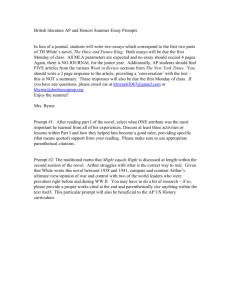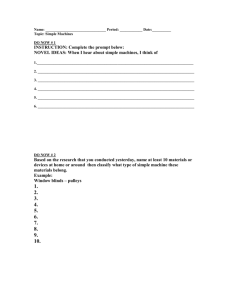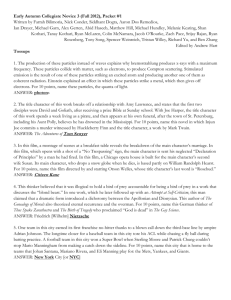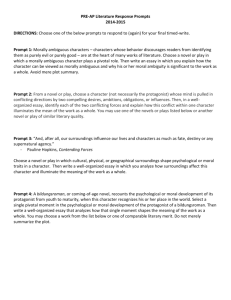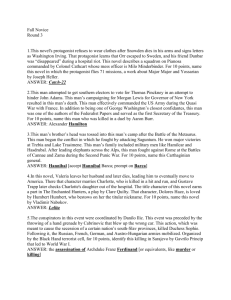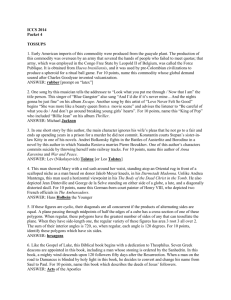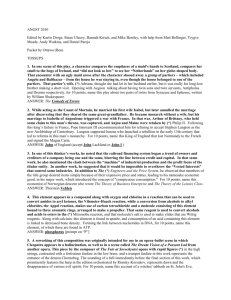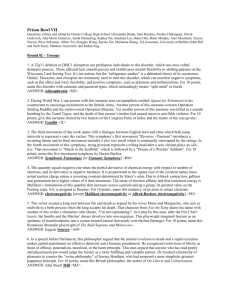MUT 2014 -- Packet 01 - Collegiate Quizbowl Packet Archive
advertisement
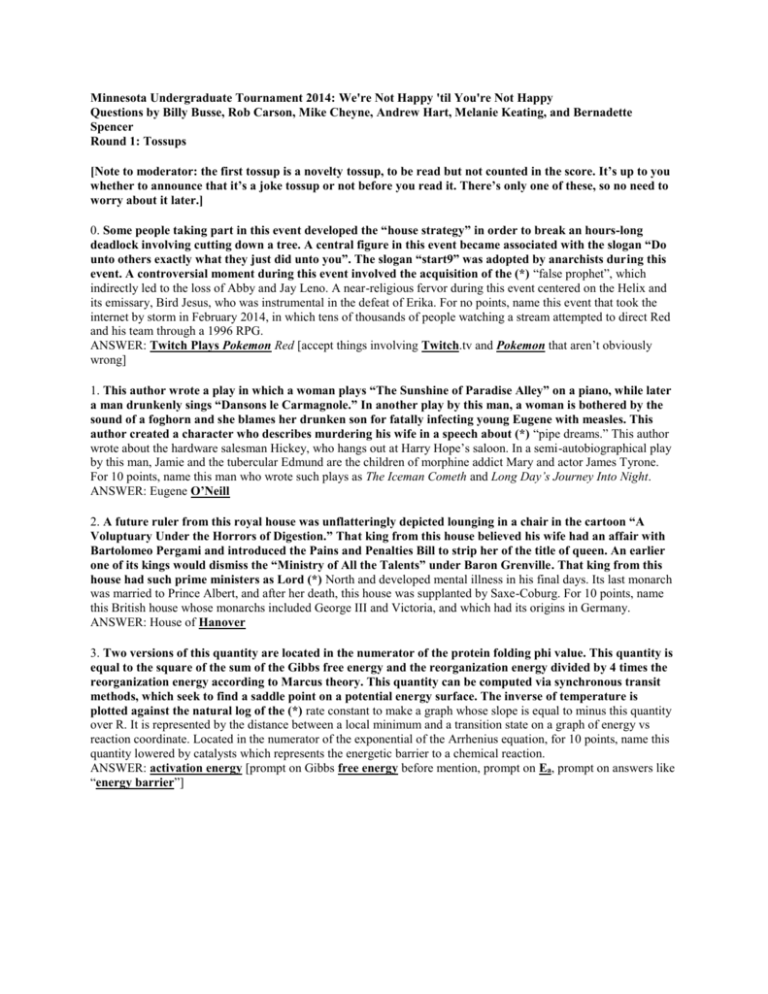
Minnesota Undergraduate Tournament 2014: We're Not Happy 'til You're Not Happy Questions by Billy Busse, Rob Carson, Mike Cheyne, Andrew Hart, Melanie Keating, and Bernadette Spencer Round 1: Tossups [Note to moderator: the first tossup is a novelty tossup, to be read but not counted in the score. It’s up to you whether to announce that it’s a joke tossup or not before you read it. There’s only one of these, so no need to worry about it later.] 0. Some people taking part in this event developed the “house strategy” in order to break an hours-long deadlock involving cutting down a tree. A central figure in this event became associated with the slogan “Do unto others exactly what they just did unto you”. The slogan “start9” was adopted by anarchists during this event. A controversial moment during this event involved the acquisition of the (*) “false prophet”, which indirectly led to the loss of Abby and Jay Leno. A near-religious fervor during this event centered on the Helix and its emissary, Bird Jesus, who was instrumental in the defeat of Erika. For no points, name this event that took the internet by storm in February 2014, in which tens of thousands of people watching a stream attempted to direct Red and his team through a 1996 RPG. ANSWER: Twitch Plays Pokemon Red [accept things involving Twitch.tv and Pokemon that aren’t obviously wrong] 1. This author wrote a play in which a woman plays “The Sunshine of Paradise Alley” on a piano, while later a man drunkenly sings “Dansons le Carmagnole.” In another play by this man, a woman is bothered by the sound of a foghorn and she blames her drunken son for fatally infecting young Eugene with measles. This author created a character who describes murdering his wife in a speech about (*) “pipe dreams.” This author wrote about the hardware salesman Hickey, who hangs out at Harry Hope’s saloon. In a semi-autobiographical play by this man, Jamie and the tubercular Edmund are the children of morphine addict Mary and actor James Tyrone. For 10 points, name this man who wrote such plays as The Iceman Cometh and Long Day’s Journey Into Night. ANSWER: Eugene O’Neill 2. A future ruler from this royal house was unflatteringly depicted lounging in a chair in the cartoon “A Voluptuary Under the Horrors of Digestion.” That king from this house believed his wife had an affair with Bartolomeo Pergami and introduced the Pains and Penalties Bill to strip her of the title of queen. An earlier one of its kings would dismiss the “Ministry of All the Talents” under Baron Grenville. That king from this house had such prime ministers as Lord (*) North and developed mental illness in his final days. Its last monarch was married to Prince Albert, and after her death, this house was supplanted by Saxe-Coburg. For 10 points, name this British house whose monarchs included George III and Victoria, and which had its origins in Germany. ANSWER: House of Hanover 3. Two versions of this quantity are located in the numerator of the protein folding phi value. This quantity is equal to the square of the sum of the Gibbs free energy and the reorganization energy divided by 4 times the reorganization energy according to Marcus theory. This quantity can be computed via synchronous transit methods, which seek to find a saddle point on a potential energy surface. The inverse of temperature is plotted against the natural log of the (*) rate constant to make a graph whose slope is equal to minus this quantity over R. It is represented by the distance between a local minimum and a transition state on a graph of energy vs reaction coordinate. Located in the numerator of the exponential of the Arrhenius equation, for 10 points, name this quantity lowered by catalysts which represents the energetic barrier to a chemical reaction. ANSWER: activation energy [prompt on Gibbs free energy before mention, prompt on Ea, prompt on answers like “energy barrier”] 4. The 2000 restoration of one of this man’s paintings revealed that a false blue sky had been painted over its top right corner. A nymph washes the central figure’s feet in that painting, this man’s Diana and her Companions. A crumpled piece of sheet music and a floor brush appear in the foreground of a painting by this artist in which a woman holding a cittern is presented the title (*) Love Letter. That painting uses the same black and white tiled marble floor as a work by this man depicting a lady standing at the virginal while her instructor looks on. This artist may have used a camera obscura to make such photorealistic paintings as The Music Lesson. For 10 points, name this Dutch artist who depicted his hometown in the View of Delft and also painted The Girl with the Pearl Earring. ANSWER: Johannes Vermeer [or Jan or Johan Vermeer] 5. A trip to this country inspired the 1939 travelogue The Lawless Roads. Recurring motifs in a novel set here include posters for the film The Hands of Orlac and a horse branded with the number seven. The expatriate dentist Mr. Tench observes the death of the protagonist of a novel set in this country, which is also the setting of a novel in which the filmmaker Jacques Laruelle may have had an affair with Yvonne, the wife of the exconsul Geoffrey (*) Firmin. The protagonist of a novel set here is hidden in a barn by Coral Fellows and encounters his illegitimate daughter Brigitta while fleeing from the Lieutenant. This country is the setting of Malcolm Lowry’s Under the Volcano, which takes place on the Day of the Dead. For 10 points, name this country where the “whisky priest” from Graham Greene’s The Power and the Glory travels through Tabasco. ANSWER: Mexico [accept the United Mexican States or Estados Unidos Mexicanos] 6. After a battle in this country, Jacob Smith ordered the execution of all those older than ten, and the Macabebe Scouts here were led by General Frederick Funston. A revolution here was led by Cardinal Jaime Sin and culminated in the successful “snap elections.” The grandfather of this country’s current leader was assassinated in 1983 by his military escort at the airport in the capital city. This country’s dictatorship was toppled in the 1980s (*) People Power Revolution, causing a first lady who owned over a thousand shoes to leave the country. A revolt against American occupation here was led by Emilio Aguinaldo. For 10 points, name this country in the Pacific once led by Ferdinand and Imelda Marcos and now led by Benigno Aquino III. ANSWER: Republic of the Philippines 7. It has nothing to do with retinopathy, but the characteristic leaky vasculature present in tissues affected by this disorder allows for drugs targeting against it via the EPR effect. Anthracyclines are a class of antibiotic used to treat this non-bacterial disorder. 5-FU combats this disorder by inhibiting the action of thymidylate synthase. Another type of drug used to treat this disorder are topoisomerase inhibitors. Alkylating agents and (*) cisplatin work to combat this disorder by chemically modifying DNA in a way which leads to apoptosis. The protein p53 works to prevent the onset and spread of this disorder. This disorder spreads from its initial site to other tissues in a process termed metastasis. For 10 points, name this disorder characterized by rapid out-of-control cell growth. ANSWER: cancer 8. In Thailand, silk brocade is tied to a certain type of these objects to appease the Nang Takien spirit that lives in them. Shintos often decorate parts of the sakaki type of this thing with washi or silk to create tamagushi offerings to kami. Priests of the Oracle of Dodona divined Zeus’ will by listening to a sacred one of these things. The Israeli Tu B’Shvat seder involves eating the their products and is also called the New (*) Year of these objects. The Vajrashila in front of a peepal one of these things marks where Buddha sat for a week before he reached enlightenment, and Eve was convinced by a snake to eat the fruit of one of these things. For 10 points, name these large plants, exemplified by the Bodhi, as well as those “of Life” and “of Knowledge”. ANSWER: trees [reverse prompt on “branches”, “leaves”, “trunk”, or other parts of trees, I guess] 9. A character in this game wrote a “study in duality” called When One Becomes Two, Problems Can Arise and is named Dr. Ray De Angelo Harris. The player receives a signed photo of Frank Mathers for completing an assignment given by his widow Abigail at the Sonar Collections Dock in Paleto Bay. After the events of “Monkey Business,” one character in this game will receive phone calls from Patricia Madrazo. Antagonists in this game include Triad leader Wei Chang, corrupt (*) FIB agent Steve Haines and corporate raider Devin Weston. It opens with a prologue set during a Ludendorff bank robbery, and it culminates in a heist at the Los Santos Union Depository. For 10 points, name this 2013 game starring Franklin Clinton, Michael De Santa, and Trevor Phillips, the latest in a series of Rockstar-developed open-world crime games. ANSWER: Grand Theft Auto V [or GTA 5; prompt on “Grand Theft Auto” or “GTA”] 10. This element’s inosilicate is known as wollastonite. This element is NOT present in forsterite and fayalite, but it is present in kirschsteinite and monticellite. The first plagioclase to crystallize according to Bowen’s reaction series is entirely a feldspar of this element; this element gets replaced with sodium as you move farther away from anorthite. This cation is found in Iceland spar and (*) aragonite. Along with magnesium, this cation is the most common source of water hardness. A mineral composed of this element, phosphate, and hydroxide is known as hydroxyapatite. This element’s sulfate dihydrate is the mineral gypsum. For 10 points, the mineral with a Mohs hardness of 3 takes it name from what element found in teeth and bone? ANSWER: calcium [prompt on “Ca”] 11. During a debate in this election, a candidate saying “Let me finish” in response to no interruption led some to accuse him of being “wired” with a radio. A failed candidate for the Democratic nomination in this election claimed his fifth place finish at New Hampshire was leading to “Joementum.” In a debate in this election, the Republican candidate responded to a list of “Great Britain” and “Australia” with the sentence “Well, actually, he (*) forgot Poland.” In the Democratic primaries, the third place finisher in Iowa was mocked for his full-throated scream; that man was Howard Dean. The losing candidate in this election was attacked by the Swift Boat Vets for Truth group regarding his Vietnam War service. For 10 points, name this presidential election where John Kerry lost to the incumbent, George W. Bush. ANSWER: Election of 2004 12. One author used this language to write a poem that asks whether a child who hears his mother call him to suckle would question whether the mother could prove that the child would find comfort in the milk. Another poem in this language contrasts the lover, who is “a dead thing,” with the beloved, who “is all in all.” Another poet used this language to write a set of poems that inspired Saki’s pen name and includes the line “the (*) moving finger writes.” A set of quatrains including the line “a jug of wine, a loaf of bread, and thou,” which were translated into English by Edward FitzGerald, were originally written in this language. It was also used to write the Masnavi, or Spiritual Couplets, of Rumi. For 10 points, name this language that Omar Khayyam used to write his Rubaiyat. ANSWER: Persian [or Farsi] 13. This director made a film which begins with the protagonist saying the lines “And though I can fight, I’d much rather recite—that’s entertainment.” That movie by this man has opening credits featuring the title character jumping in slow motion as the Intermezzo from Cavalleria rusticana plays. In another of this director’s films, the protagonist takes Betsy to see a Swedish sex education film. That character cuts his hair into a Mohawk while planning to kill a senator, a scene which John (*) Hinckley tried to emulate by shooting Ronald Reagan. This director made a film about the disturbed loner Travis Bickle, who at one point says “You talkin’ to me?” when looking in a mirror. He also filmed the life story of boxer Jake La Motta, who was played by his frequent star, Robert De Niro. For 10 points, name this director of such films as Taxi Driver and Raging Bull. ANSWER: Martin Scorsese 14. This continent was the site of a study by Jacques Lizot that partly inspired Clifford Geertz to write a New York Review of Books article titled “Life Among the Anthros.” A study on this continent inspired the claim that a researcher exacerbated a measles outbreak in a 2000 book by Patrick Tierney. In a 1955 memoir, an anthropologist noted that it had been about 15 years since he left a country on this continent after saying that he will recount his travels despite “hat[ing] traveling and explorers.” In that work, (*) Tristes Tropiques, Claude Levi-Strauss discussed his fieldwork on this continent among the Tupi-Kawahib, Nambikwara, Caduveo, and Bororo peoples. Napoleon Chagnon did fieldwork on this continent among a tribe he called the “fierce people.” For 10 points, name this continent on which the Yanomami people inhabit the Amazon basin. ANSWER: South America 15. In the Dirac-Pauli representation, an operator partially named for this quantity takes the form of i times the 2nd gamma matrix; that operator doesn’t change helicity, but it flips the sign of all additive quantum numbers. Lines running from the top left to the bottom right of an Eightfold Way diagram represent particles with the same value for this quantity. The symmetry named for this quantity is combined with (*) parity symmetry to form a symmetry violated by the weak force. The value of this quantity for the electron was determined by a measurement of the falling velocity of oil drops by Robert Millikan. Equal to two-thirds for the up quark and minus one-thirds for the down quark, for 10 points, name this quantity which for the electron is minus 1.6 times 10 to the minus 19 coulombs. ANSWER: electric charge [accept “charge conjugation”] 16. This writer distinguished between learning through description and learning through acquaintance in a work that introduces the Cartesian method of doubt with the example of a table. This man attempted to solve the problem of negative existentials in a work that claimed that “Aristotle” was not a name but a description. That work by this man also criticized Meinong and rejects the distinction between propositions and truth values proposed in (*) Frege’s On Sense and Reference. This author of The Problems of Philosophy and “On Denoting” introduced his namesake paradox in naive set theory in a work that attempted to explain mathematics with axiomatic logic. For 10 points, name this British philosopher who co-wrote Principia Mathematica with Alfred North Whitehead. ANSWER: Bertrand Russell [or Bertrand Arthur Williams Russell, 3rd Earl Russell] 17. This man was described as a “philosopher of multiplicity” in the final section of Emerson’s Representative Men. He poetically accused Friedrich Nicolai of defecating on the grave of one of his characters, while another of his characters visits an inn which bears the motto “ubi homines sunt, modi sunt” and travels to the Pedagogical Province with his son Felix. That character puts on a performance of Hamlet before joining the (*) Tower Society in the first novel this man wrote about him. He also wrote a novel whose protagonist is buried under a linden tree after an awkward nighttime reading of Ossian prompts him to shoot himself in order to assure Albert and Lotte’s happiness. For 10 points, name this creator of Wilhelm Meister, the German author of The Sorrows of Young Werther and Faust. ANSWER: Johann Wolfgang von Goethe 18. During this war, a priest wrote the text Cautio Criminalis, which questioned the prosecution of witches. The expression “I know my fellow Pappenheims” refers to an officer in this war, and its battles included the defeat of the Spanish at the Battle of Rocroi and the miserable Battle of the Rain. A commander in it was assassinated on orders of Emperor Ferdinand II when he contemplated switching sides; that man was (*) Albrecht von Wallenstein. This conflict featured such leaders as the Swedish king Gustavus Adolphus and was ended by the Peace of Westphalia. For 10 points, name this war which effectively pitted Protestant and Catholic alliances against each other, fought primarily in modern-day Germany between 1618 and 1648. ANSWER: Thirty Years’ War 19. Drops of blood generated during one of this man’s adventures gave rise to the creature that killed the Argonaut seer Mopsus. One story tells of how this man exchanged kingdoms with his cousin Megapenthes. Pausanias claimed that during a visit to Larissa, he invented the quoit, with which he accidentally killed his grandfather Acrisius. The Hesperides gave a kibisis to this man, who was raised on Seriphos by a (*) fisherman named Dictys. This man slew the monster Cetus, thus circumventing a prophecy that the oracle of Ammon had given to Cepheus and Cassiopeia. This man stole the tooth and eye shared by the Graeae while on one quest and ended another by rescuing and marrying Andromeda. For 10 points, name this son of Zeus and Danae who killed the Gorgon Medusa. ANSWER: Perseus 20. A G minor composition by this man opens with an unusual arpeggio based on a Neapolitan sixth chord and, unlike his other works in the same genre, contains a 2/2 presto con fuoco coda and is largely written in 6/4 time. Another of his pieces opens with a theme in D flat major before shifting to C sharp minor, and uses repeated A flats to evoke the title effect. He used a duet from Don Giovanni as the basis for his Variations on “Là ci darem la mano”, which prompted (*) Robert Schumann to exclaim “Hats off, gentlemen! A genius!” He also used D-flat major for the last of his Trois Nouvelles Etudes, the twentieth of his 41 mazurkas, and a molto vivace piece inspired by a dog chasing its tail. For 10 points, name this inventor of the instrumental ballade, the Polish composer of the Raindrop Prelude and the Minute Waltz. ANSWER: Frédéric François Chopin [or Fryderyk Franciszek Chopin] TB. Harrison Hayford and Merton Sealts produced the “genetic” 1962 edition of this book, whose manuscript was rediscovered by its author’s biographer Raymond Weaver. Its final chapter is a ballad which depicts its main character “in the Darbies.” That character impresses Red Pepper by shooing away an afterguardsman and befriends a scarred man referred to as a “Dansker”. In its climactic event, a character is said to be “struck dead by an (*) angel of God,” though he was actually punched in the head by the stuttering title character. That title character says “God bless Captain Vere!” shortly before being hanged for his accidental murder of the master-at-arms John Claggart. For 10 points, name this novella about a sailor impressed aboard the Bellipotent, by Herman Melville. ANSWER: Billy Budd, Sailor [accept Billy Budd, Foretopman] Minnesota Undergraduate Tournament 2014: We're Not Happy 'til You're Not Happy Questions by Billy Busse, Rob Carson, Mike Cheyne, Andrew Hart, Melanie Keating, and Bernadette Spencer Round 1: Bonuses 1. Despite being no less musical than “the birds that sang in the hedge”, this person was unable to gain work on the stage, and so after being impregnated by Nick Greene, the “heat and violence” of her poet’s heart led her to commit suicide. For 10 points each: [10] Identify this hypothetical person who would have “had no chance of learning grammar and logic, let alone Horace and Virgil” and, as a result, had few opportunities, according to a 1929 essay. ANSWER: Judith Shakespeare [or Shakespeare’s sister; prompt on “Shakespeare”] [10] Judith Shakespeare was hypothesized in “A Room of One’s Own”, an extended essay by this modernist female author of Mrs. Dalloway and To the Lighthouse. ANSWER: Virginia Woolf [or Adeline Virginia Woolf] [10] Woolf also wrote Flush, a semi-fictional pseudo-biography of a cocker spaniel belonging to this earlier female author of Casa Guidi Windows, Aurora Leigh, and a poem beginning “Yes, call me by my pet name!” ANSWER: Elizabeth Barrett Browning [or Elizabeth Barrett; or Elizabeth Barrett Moulton-Barrett; prompt on “Browning”] 2. Charles Eugene de Croy was taken prisoner in this battle. For 10 points each: [10] Name this November 1700 battle in which the Swedish forces under Charles XII won an early decisive victory over the Russians in the Great Northern War. ANSWER: Battle of Narva [10] The leader of Russia at this time was this monarch, who was noted for modernizing the country and for instituting policies like a “beard tax.” He would eventually lead Russia to victory against the Swedish. ANSWER: Peter the Great [or Peter I; or Pyotr Alexeyevich] [10] While Peter was touring Europe, these units of Russian guards launched a 1689 rebellion. These marksmen had supported the Cossack Stepan Razin in a 1670’s uprising. ANSWER: the streltsy [prompt on shooters] 3. Four manifestations of this deity represented the four cardinal directions. For 10 points each: [10] Name this god who was worshipped at the Templo Mayor alongside Huitzilopochtli, and who ruled over people who died from water-related causes and the victims of child sacrifice. ANSWER: Tlaloc [10] Tlaloc was the rain and storm god of these Mesoamerican people, who fatally mistook the arrival of Hernán Cortés for the return of their feathered-serpent god Quetzalcoatl. ANSWER: Aztecs [or Aztecatl] [10] Tlaloc was very similar to the storm deity Cocijo, who was the chief god of this other pre-Columbian Mesoamerican civilization. ANSWER: Zapotecs 4. Name some things related to the Israelites’ move to Egypt, for 10 points each. [10] The Israelites moved to Egypt after this son of Jacob became a powerful advisor to the Pharaoh. This man had predicted his rise to power in a series of dreams he told to his brothers. ANSWER: Joseph [or Yosef; or Yusuf; or Yosep] [10] Joseph was the son of this wife of Jacob, who died giving birth to his brother, Benjamin. This younger daughter of Laban gave her maid Bilhah to Jacob as a concubine. ANSWER: Rachel [or Rahel; or Rakhel] [10] The Israelites were granted settlement in this area near the Nile Delta. This land was the starting point for the Exodus. ANSWER: Land of Goshen [or Gesem; or Eretz Gosen] 5. Answer the following about the greatest of all angles, the Bürgi-Dunitz angle, for 10 points each: [10] The Bürgi-Dunitz angle is the angle of attack for a nucleophile reacting with one of these moieties. This moiety is present in the dienophile in an oxo-Diels-Alder reaction, and two of these moieties are linked by an oxygen atom in an acid anhydride. ANSWER: carbonyl [10] The Bürgi-Dunitz angle is the location at which the “highest occupied” one of these constructs for the nucleophile has maximum overlap with the “lowest unoccupied” one of these constructs for the carbonyl. The atomic and molecular types of these constructs describe the delocalization of electrons in an atom or molecule. ANSWER: orbitals [10] The Bürgi-Dunitz angle is approximately 107 degrees above the plane of the carbonyl. The carbonyl lies in a single plane because its central carbon is in this hybridization, which is the hybridization of trigonal planar compounds such as boron trifluoride. ANSWER: sp2 6. This experiment was stopped shortly after objections from graduate student Christina Maslach. For 10 points each: [10] Name this experiment conducted by Philip Zimbardo at a California university, in which he assigned students roles of prisoners or guards. This experiment demonstrated the abuse of authority from people with power. ANSWER: Stanford prison experiment [10] During the experiment, one especially cruel “guard” received this nickname, a reference to a Hollywood actor, even though he was attempting to copy Strother Martin’s performance from Cool Hand Luke. ANSWER: “John Wayne” [do not accept other answers, the nickname was “John Wayne”] [10] Another study conducted at Stanford, this one by Walter Mischel, offered children a small reward immediately or two rewards if they waited for some time, in order to test delayed gratification. The study is commonly known by this name, referring to the foodstuff offered the children. ANSWER: Stanford marshmallow experiment 7. This man painted the death of a hunter in The Last Trek. For 10 points each: [10] Name this English artist who was severely criticized for depicting working-class realism in a painting set in a carpentry workshop, Christ in the House of His Parents. ANSWER: John Everett Millais [10] The painting helped launch this English art movement to prominence. Other members included William Holman Hunt and Dante Gabriel Rossetti, and its name references a Renaissance artist. ANSWER: Pre-Raphaelite Brotherhood [or PRB] [10] This English art critic supported the Pre-Raphaelites and was also the author of The Seven Lamps of Architecture. This author of Modern Painters claimed that James Whistler’s Nocturne in Black and Gold was equivalent to “flinging a pot of paint in the public’s face.” ANSWER: John Ruskin 8. This man took his pen name from the banana tree that his followers planted outside his rustic hut. For 10 points each: [10] Name this poet who added his own commentary to the results of a poetry contest in The Seashell Game and wrote the poetic travelogue Narrow Road to the Deep North. ANSWER: Matsuo Basho [or Matsuo Kinsaku; or Matsuo Chuemon Munefusa] [10] Basho wrote that he loathed to see a miscanthus budding next to his banana plant in this Japanese poetic form that is comprised of three lines of five, seven, and five morae. ANSWER: haiku [accept hokku or haikai] [10] This contemporary female Japanese writer of Kitchen and Asleep, whose real first name is Mahoko, probably did not consider Basho when choosing her new fruit-related English first name. ANSWER: Banana Yoshimoto 9. A commander in this war died in the pivotal Battle of the Metaurus. For 10 points each: [10] Name this war, in which the winning side bid for time using the Fabian strategy. The eventual winner would rebound from devastating losses at Lake Trasimene and Cannae. ANSWER: Second Punic War [prompt on Punic War, prompt on answers involving Rome fighting Carthage or Hannibal] [10] In the Second Punic War, Rome ultimately triumphed against this rival empire located in modern-day North Africa. It was fully destroyed after the Third Punic War. ANSWER: Carthage [or the Carthaginians] [10] At the Battle of the Metaurus, this Carthaginian general and brother of Hannibal died. This man’s head was thrown into his brother’s camp afterwards. ANSWER: Hasdrubal Barca [or Hasdrubal II] 10. Sarrus’ Rule is a shortcut method for computing this operation for a 3x3 matrix. For 10 points each: [10] Name this operation which can be determined for an n-dimensional square matrix recursively via cofactor expansion. For a 2x2 matrix with first row (a,b) and second row (c,d), this operation yields ad minus bc. ANSWER: determinant [10] Elementary row operations can be used to find one of these sets of vectors for a matrix’s row space or column space. This is a linearly independent set of vectors which spans a vector space. ANSWER: basis [10] This operation for a square matrix is equal to the sum of its eigenvalues. Transposing a matrix does not change the value of this operation, since it is defined as the sum of the elements on the main diagonal. ANSWER: trace 11. Its first part contains an attack on the “Crystal Palace” proposed in Chernyshevsky’s What Is to Be Done?, while in its second part, “Apropos of the Wet Snow”, the narrator goes to a party for his school friend Zverkov. For 10 points each: [10] Name this existentialist 1864 novella whose narrator spends most of its second half involved in an intensely conflicted relationship with a prostitute named Liza. ANSWER: Notes from the Underground [or Zapiski iz podpol'ya; or Letters from the Underground; accept “Underworld” for “Underground”] [10] Notes from Underground was written by this epileptic Russian author of Crime and Punishment and The Brothers Karamazov. ANSWER: Fyodor Mikhailovich Dostoyevsky [or Dostoevsky] [10] After being arrested and imprisoned for his membership in the Petrashevsky Circle, Dostoevsky channeled his prison experiences into this novel, which chronicles Aleksandr Goryanchikov’s deportation to a Siberian camp. ANSWER: Memoirs from the House of the Dead [or Notes from the Dead House; accept “Notes” for “Memoirs” or vice versa] 12. In “On the Basis of Morality”, Schopenhauer critiqued this work’s doctrines for lacking “real substance” and being “useless in the storms of life”. For 10 points each: [10] Name this work that claimed the distillation of common sense ethics leads to a single, universally applicable “supreme principle” followed because it is right. ANSWER: Groundwork of the Metaphysics of Morals; [or Grundlegung zur Metaphysik der Sitten; accept Grounding or Foundations instead of “Groundwork” and for in place of “of”] [10] In an appendix to The World as Will and Idea, Schopenhauer claimed that this author of the Groundwork formulated his own definition of objects of thought, or “noumena” in his own Critique of Pure Reason. ANSWER: Immanuel Kant [10] Schopenhauer asserted that Kant didn’t adequately “separate knowledge of perception from abstract knowledge”, thus confusing the noumena with this term for the “objective essence” of a being. ANSWER: ding an sich [or thing in itself; or thing as such; or thing as it exists] 13. During these events, sodium ions rush into the cell for a short time, followed by potassium ions rushing out of the cell. For 10 points each: [10] Name these events in which a cell membrane rapidly depolarizes then repolarizes, forming a voltage spike. ANSWER: action potentials [10] Action potentials travel down the axons of these cells which transmit electrical information via synapses. ANSWER: neurons [10] Long-term potentiation and long-term depression of synapses cause this phenomenon, in which synapses undergo a permanent change in strength. This phenomenon is thought to be important in the formation of memories. ANSWER: synaptic plasticity [accept neuroplasticity, accept word forms of “plasticity”] 14. Bassoons introduce this work’s third section, a setting of the comic song “Was kommt dort von der Höh”, also known as the “fox song”. For 10 points each: [10] Identify this concert piece that also quotes the graduation song “Gaudeamus igitur”, written to thank the University of Breslau for bestowing an honorary degree on its composer. ANSWER: the Academic Festival Overture [or the Akademische Festouvertüre] [10] The Academic Festival Overture was composed by this German, whose first symphony was nicknamed “Beethoven’s Tenth”. This man composed A German Requiem and a famous lullaby. ANSWER: Johannes Brahms [10] The Academic Festival Overture was partly inspired by the work of this man, who quoted “Gaudeamus igitur” in his overture to Flotte Burschen. This Austrian also composed Morning, Noon, and Night in Vienna and Light Cavalry. ANSWER: Franz von Suppé [or Francesco Ezechiele Ermenegildo Suppé Demelli] 15. Answer the following about western exploration and settlement in America, for 10 points each. [10] It’s unclear how many people actually drowned fording a river while traveling on the real-life Oregon Trail, but it is clear that the most famous Oregon Trail route began in this Missouri city, which was also the hometown of Harry Truman. ANSWER: Independence [10] This frontiersman notably served as John Fremont’s guide through the California and Oregon territories. He and James Carleton were later blamed for the forced Navajo relocation in the Long Walk. ANSWER: Christopher “Kit” Carson [10] This 1860-1861 business was a mail service delivering messages from St. Joseph, Missouri, to the west by horseback. Despite its fame, it only lasted eighteen months. ANSWER: Pony Express 16. This man’s last known communication was a potentially fictitious letter he sent to his friend Blanche Partington. For 10 points each: [10] Name this man who disappeared in Mexico in 1913, possibly while following around Pancho Villa’s army. This author is the inspiration for Carlos Fuentes’ novel The Old Gringo, and he wrote a story about the hanging of Peyton Farquhar. ANSWER: Ambrose Gwinnett Bierce [10] Bierce’s most famous short story, “An Occurrence at Owl Creek Bridge,” takes place during this war, which is also the subject of Stephen Crane’s novel The Red Badge of Courage. ANSWER: The American Civil War [or War of Northern Aggression, or War Between the States] [10] In Bierce’s story “Chickamauga,” the protagonist is a young boy who eventually discovers that his house has been set on fire. The boy suffers from what physical disability? ANSWER: deaf-mute [accept deafness, accept muteness, accept obvious equivalents] 17. This operation, which is only defined on a Hilbert space, is analogous to the Poisson bracket from Hamiltonian mechanics. For 10 points each: [10] Name this operation which for two operators A and B is simply defined as AB minus BA. ANSWER: commutator bracket [10] This principle can be explained by the fact that position and momentum obey a canonical commutation relation. It states that the product of the standard deviations of the measurements of position and momentum must be larger than h-bar over 2. ANSWER: Heisenberg uncertainty principle [either of the two underlined words is sufficient] [10] The commutator of position and momentum equals this constant times h-bar. The impedance of a circuit element equals its resistance plus this constant times its reactance, which allows the current through it to be represented using a phasor. ANSWER: i [or the imaginary unit, or the square root of negative one] 18. This organization’s president, Vivian Schiller, resigned after referring to the Tea Party as “gun-toting” racists. For 10 points each: [10] Name this media organization, a non-profit broadcasting corporation which airs such programs as All Things Considered and repeats of Car Talk. ANSWER: NPR [or National Public Radio] [10] This popular news game show on NPR features a panel of three people playing various humorous games related to news stories. Listeners can win an answering machine message from scorekeeper Carl Kasell. ANSWER: Wait Wait…Don’t Tell Me! [10] In 2010, NPR terminated the contract of this journalist after he admitted he was nervous about flying with people dressed in “Muslim garb.” This man frequently appears on FOX News and was the author of the book Eyes on the Prize. ANSWER: Juan Williams 19. It opens with a prelude in which various instruments spend nearly four minutes working an E flat major chord as the strings play a “wave” motif, representing the motion of a river. For 10 points each: [10] Identify this first opera of the Ring Cycle, in which the dwarf Alberich steals the title treasure. ANSWER: Das Rheingold [or The Rhine Gold] [10] This German operatic composer, whose works based on Arthurian myth include Tristan and Isolde and Parsifal, composed the Ring Cycle. ANSWER: Richard Wagner [10] This early Wagnerian opera, his third, is based on a Bulwer-Lytton novel. It ends as the Roman capitol is burned while the title “last of the tribunes” and his followers are inside. ANSWER: Rienzi, der Letzte der Tribunen [or Rienzi, the Last of the Tribunes] 20. A member of this group to be executed was Sir John Oldcastle, the possible inspiration for Shakespeare’s Falstaff. For 10 points each: [10] Name this group of supporters of John Wycliffe, who opposed the power of the Catholic Church in England. Their humorous sounding name may refer to a Dutch expression meaning “mumbling” or “babbling.” ANSWER: Lollards [accept word forms] [10] The Lollards were opposed by Thomas Arundel, who held this position in the 1390’s. This position was more famously held by Thomas Becket and is currently considered to be the leader of the Church of England. ANSWER: Archbishop of Canterbury [10] Wycliffe was declared a heretic at this Catholic council held from 1414 to 1418. More notably, this council elected Pope Martin V and executed Jan Hus. ANSWER: Council of Constance TB. This man killed himself in the Catete Palace in 1954. For 10 points each: [10] Name this man who led his county from 1930 to 1945, before a brief return in the 1950’s. He represented the end of the old café com leite politics and as a dictator grew to oppose the fascist Integralism movement. ANSWER: Getulio Vargas [10] Vargas and his Estado Novo government ruled this South American country. His government should not be confused with the Estado Novo in Portugal, which also used to rule this nation. ANSWER: Federative Republic of Brazil [10] This last monarch of Brazil was emperor when the Golden Law of 1888 abolished slavery in the country. It was signed by this man’s daughter, Isabel, while he was in Europe. ANSWER: Pedro II
